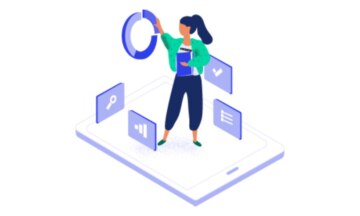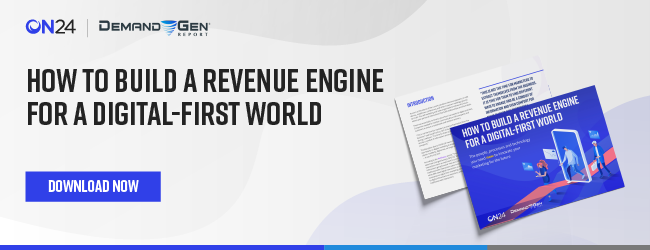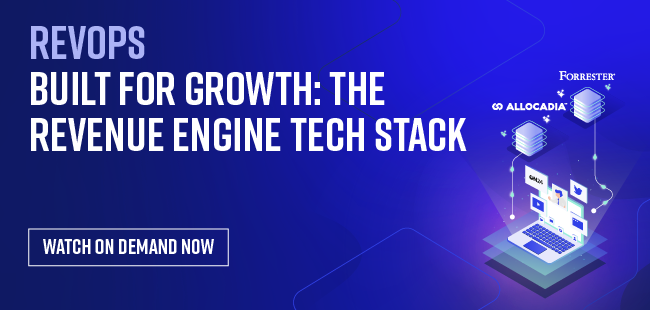Among the many changes of 2020, B2B sales and marketing professionals saw annual conferences, summits and events yanked from calendars in rapid succession. Prior to the global pandemic, these large gatherings were vital to the success of B2B organizations and the people working for them.
To make up for this loss, marketing and sales teams began to search for new ways to communicate and interact with prospects and clients. Marketing teams turned their attention to digital marketing and found ways to promote messages and the brand through methods they could never have conceived of a few months prior. Digital methods were no longer one of many options to reach prospects and serve clients. It became the only way.
ON24 teamed up with DemandGen Report to create an e-book to help B2B marketers plan for a digital-first strategy. This e-book examines the challenges marketers face as they look to fill the gaps of in-person events and the strategies that will help them succeed in a new digital-centric environment.
We’re going to highlight some of the more important content, but you can find the e-book in its entirety here.
Digital Marketing Transformed
With in-person meetings on hold for the foreseeable future, B2B marketers need to revamp their digital marketing plans and turn their department into a center of knowledge and marketing activity. Nearly every interaction and touchpoints will take place online, so prospects and customers need to find all the information they want to make their buying decision online too.
Although digital marketing has a lower participation expectation — in that people don’t always participate in the same way they would if the event was in-person — it provides trackable insights and analysis that face-to-face interactions don’t. To capitalize on the additional information about prospects and clients, all aspects of the marketing plan need to thoroughly leverage digital tactics. This is your opportunity to integrate content and data that you’ve already created but may not have found an additional use for. Find a way to transition relevant information into evergreen content that you can use to generate long-term engagement from prospects and customers.
Going Digital Across the Buyer and Customer Journey
The challenge many companies face without in-person events is communication gaps with messaging that inspires and resonates with buyers during a difficult time. The conversations have shifted away from an exclusive focus on selling to more casual conversations focused on caring for clients and prospects. These conversations now revolve more around tactics, education and providing as much help as possible.
Though there aren’t ways to fully replicate in-person engagement with digital experiences, you can figure out which parts are the most important to progressing through the buying journey or closing the deal and try to replicate those as much as possible. Organizations that do this successfully pair the appropriate content with the appropriate stage.
With these new digital experiences, it’s important to reevaluate your indicators of a qualified buyer. They most likely not the same as they were for face-to-face interactions. The time a prospect spends on a webinar and whether they participate in polls are valuable in the Education phase. For the Selection stage, focus on the number of questions they ask, quotes and meetings. When they reach the Grow stage, evaluate the account engagement and engaged minutes.
Reimagining the New Digital-First Team
With the shift toward digital marketing, the recipe for building a marketing team and how it runs also needs to change. Some traditional marketing roles will remain, but to make the most of your new strategy, responsibilities and procedures need to be reevaluated to make sure they align with the new digital plan.
With online marketing, dividing team member responsibilities by product, industry, or region no longer makes sense. The team and leadership need to look past the singular channel responsibilities and make sure all team members are focusing on relevant and productive digital marketing tasks related to various stages of the buying journey.
Along with a new marketing team structure, typical buying personas and the digital buying journey also need to be adjusted. This may be your opportunity to introduce your products or services to new industries. Organizations are looking for solutions to problems they never anticipated and if you want their business, you need to adapt to their needs.
As B2B marketing continues to adjust to the new digital landscape, team members also need to be open to developing new skills. Digital marketing requires different knowledge and proficiencies and as marketing programs grow the marketing team members need to grow with it.
Marketers and organizations that transition to digital are going to define the future. Though digital interactions can’t fully replicate some aspects of in-person interactions, digital marketing offers more insights and clearer understanding of a buyer’s intent. Marketers should capitalize on these additional analytics and set themselves up to exceed the needs of prospects and clients. Digital marketing is likely here to stay so B2B marketers and their programs need to adapt to the changing times or risk being left behind as buyers choose competitors who went digital over them.


